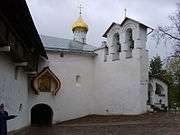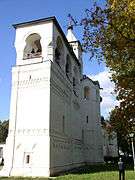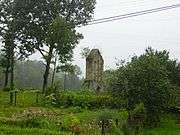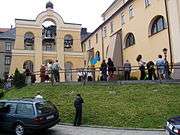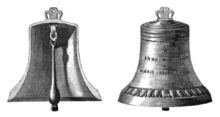Zvonnitsa

Zvonnitsa of the Transfiguration Cathedral in Vyazemy,
Moscow Oblast.
Zvonnitsa (Russian: звонница; Ukrainian: дзвіниця, dzvinytsia; Polish: dzwonnica parawanowa; Romanian: zvoniţă) is a large rectangular structure containing multiple arches or beams that carry bells, where bell ringers stand on its base level and perform the ringing using long ropes, like playing on a kind of giant musical instrument. It was an alternative to bell tower in Russian, Polish and Romanian medieval architectural tradition.
Zvonnitsa was an architectural form especially widespread in architecture of Pskov. In general, it was used in the Russian architecture of the 14th-17th centuries.
Sometimes zvonnitsa was mounted right atop the church building, resulting in the special type of church called pod zvonom (Russian: под звоном, "under ringing") or izhe pod kolokoly (Russian: иже под колоколы, "under bells"). The most famous example of such kind of a church is the Church of St. Ivan of the Ladder adjacent to Ivan the Great Bell Tower in the Moscow Kremlin.
Polish word Dzwonnica (pl:Dzwonnica) means any type of a bell tower, while the rectangular architectural construction with apertures for bells is referred to as dzwonnica parawanowa.
| Pskov. Church of St. Georg "so Vzvoza" with zvonnitsa |
| Zvonnitsa in Rostov Kremlin |
| Zvonnitsa in Saint Euthymius Monastery, Suzdal |
|
External links
|
|---|
|
Background and
terminology | | |
|---|
|
Bell founders
and foundries | |
|---|
|
| Types | |
|---|
|
| Bellringing | |
|---|
|
| Notable bells | |
|---|
|
| Related | |
|---|



